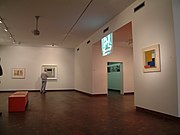Van Abbemuseum
This article needs additional citations for verification. (January 2016) |
 Entrance in the old wing of the museum | |
Location in North Brabant, Netherlands | |
| Location | Bilderdijklaan 10[2] Eindhoven, Netherlands |
|---|---|
| Coordinates | 51°26′5″N 5°28′56″E / 51.43472°N 5.48222°E |
| Type | Art museum[1] |
| Visitors | 98,100 (2012)[1] |
| Founder | Henri van Abbe[3] |
| Director | Charles Esche[4] |
| Website | www |
The Van Abbemuseum (Dutch pronunciation: [vɑn ˈɑbəmyˌzeːjʏm]) is a museum of modern and contemporary art in central Eindhoven, Netherlands, on the east bank of the Dommel River. Established in 1936, the museum is named after its founder, the cigar businessman Henri van Abbe, who loved modern art and wanted his collection to be enjoyed in Eindhoven. As of 2010, the collection of the museum housed more than 2700 works of art, of which about 1000 were on paper, 700 were paintings, and 1000 were sculptures, installations and video works.
The museum has an area of 9,825 m2 and holds one of the largest collections of paintings in the world by El Lissitzky. It also has works by Pablo Picasso and Wassily Kandinsky.
History
[edit]The museum's original collection was bought by the Eindhoven city council in 1934 in an agreement with Henri van Abbe, a private collector and local cigar manufacturer. In return for buying some of his collection, the Van Abbe factory paid for and donated the museum building, which opened in 1936. The city had architect Alexander Kropholler design a building that is a symmetrical suite of galleries in the traditionalist style. The museum name was given in publications as "Stedelijk Van Abbemuseum" until approximately 1990 and as "Van Abbemuseum" after that time.[5]

As the building had become far too small for modern demands, a new extension to the building, including a 27-metre-high (89 ft) tower, was designed by Abel Cahen; it was inaugurated in 2003 by queen Beatrix.
Collection
[edit]The original collection contained works by Jan Sluijters, Carel Willink and Isaac Israëls amongst others, mostly Dutch and Belgian contemporary works. The museum also bought other artworks from founder Henri van Abbe before his death in 1940.
The collection developed most under the directorships of Edy de Wilde and Rudi Fuchs.[6] While De Wilde bought the classical modernist works by Picasso and similar artists, Fuchs bought works from artists of his own generation, in particular conceptual work from the US and German painting.
The current[when?] director, Charles Esche has pursued a more geographically diverse collecting policy concentrating on works from central and eastern Europe including Nedko Solakov, Mladen Stilinovic, Wilhelm Sasnal, Artur Zmijewski as well as video works by Israeli artist Yael Bartana.[citation needed]
More recent acquisitions include pieces by Pablo Picasso, Wassily Kandinsky and Piet Mondrian. The museum is also internationally renowned for having one of the largest collections of works by El Lissitzky.[citation needed]
The Van Abbemuseum also houses the collection of posters made by the Situationist Jacqueline de Jong in Paris during May 1968.[citation needed]
Administration
[edit]The first director was W.J.A. Visser, from 1936.[7] He remained director until the start of the Second World War but stood down as he could not agree with the policy of the German invaders. He retook the position for a short while after the war, but in 1946 Edy de Wilde took over.
During De Wilde's directorship, various cubist and modern works were purchased. This included Femme en vert by Picasso (for around 110.000 Dutch guilders, at the same a considerable sum) and Hommage à Apollinaire by Marc Chagall. Nevertheless, De Wilde received criticism: the sons of van Van Abbe believed that De Wilde was showing too few of their father's works. De Wilde disagreed and continued with his one direction. He remained director until 1964, after which Jean Leering became his successor.[8]
Leering tried during his directorate to present less elitist art and heighten the museum's social engagement. He also wanted to engage a younger audience in contemporary art by inviting secondary school pupils to attend private viewings and to initiate discussion over the recent acquisitions. This was the context in which the blue monochrome canvas by Yves Klein was purchased. Leering remained director until 1973, from which date Rudi Fuchs took over. Fuchs continued until 1987 when Jan Debbaut succeeded him.[9]
Under the directorship of Debbaut, the museums's greatest changes took place, largely thanks to the increase in exhibition space through the construction of a renovated building.[10] Once the extended building was opened, Debbaut retired to be replaced in 20024 by the current museum director, Charles Esche.[11]
The museum had 96,750 visitors in 2011 and 98,100 visitors in 2012.[1]
Gallery
[edit]-
Main entrance
-
Entrance of old buildings to new buildings, Rädecker John.
-
Part of the new wing
-
New and old buildings. In the foreground of the house Körmeling
-
See-through five floors of the building
References
[edit]- ^ a b c "Meer bezoekers voor Van Abbemuseum in Eindhoven" (in Dutch), Eindhovens Dagblad, 2012. Retrieved 17 January 2016.
- ^ Home, Van Abbemuseum. Retrieved 17 January 2016.
- ^ "Achterkleinzoon Albert van Abbe over kunst en het museum" (in Dutch), Eindhovens Dagblad, 2011. Retrieved 17 January 2016.
- ^ "Directeur van Tate bovenaan Power 100 2014" (in Dutch), Kunstbeeld, 2014. Retrieved 17 January 2016.
- ^ Based on search of Library of Congress catalog, September 17, 2015.
- ^ "Stedelijk Exhibitions". Retrieved 17 November 2018.
- ^ "Founder and directors". vanabbemuseum.nl. Retrieved 2023-04-27.
- ^ "Biografie Jean Leering". valiz.nl (in Dutch). Retrieved 2024-11-22.
- ^ Grrr.nl. "Opwinding - Een tentoonstelling van Rudi Fuchs". www.stedelijk.nl (in Dutch). Retrieved 2024-11-22.
- ^ "Van Abbe Museum eindhoven". 2008-06-04. Archived from the original on 2008-06-04. Retrieved 2023-04-27.
- ^ "Interview met Charles Esche, directeur van het Van Abbemuseum". Stichting Ammodo (in Dutch). Retrieved 2024-11-22.












